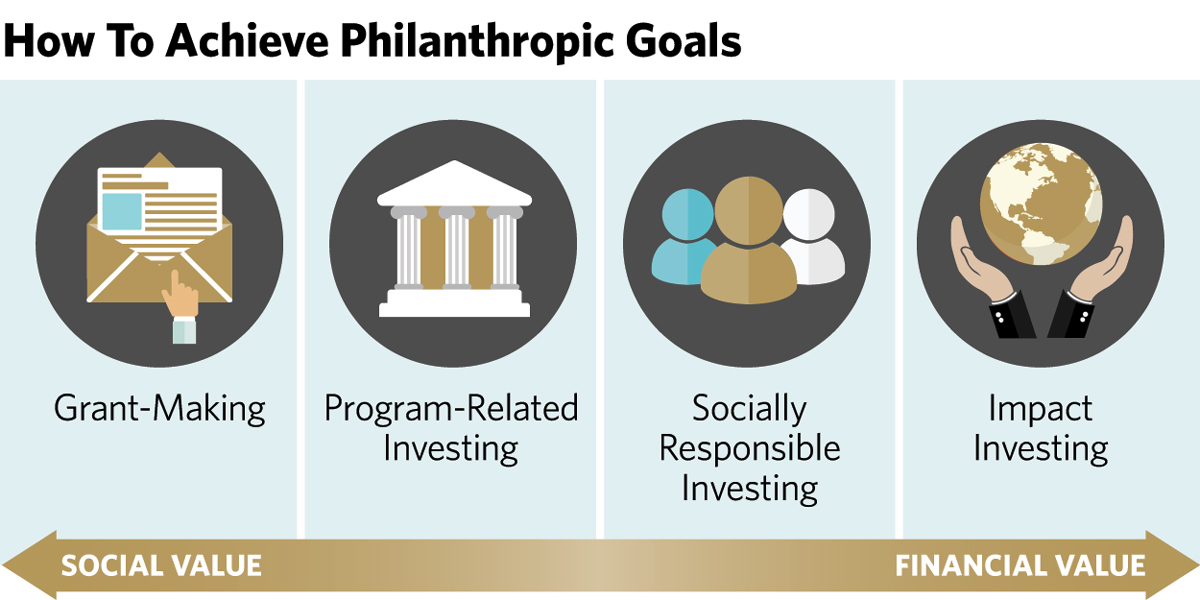As a philanthropy advisory firm, we are seeing a substantial uptick in the number of clients exploring and pursuing all the tools in the philanthropic toolbox in service of their charitable mission. One of those tools is impact investing. High-net-worth and ultra-high-net-worth donors are beginning to see the value of using some of their capital, their financial investments, as another way to address the issues they care about most. They are taking a stand for change by putting their philanthropic capital to work in service of their mission. Whether they are making direct investments in social enterprises; choosing environmental, social and governance investing; or seeking investments aligned with sustainable development goals, they are seeking an expanded approach to reaching their charitable giving goals. Donors are finding themselves acting as shareholder advocates in proxy voting, providing program-related investments or participating in community development banks. Each of these strategies, despite their differences, is helping the philanthropic investor effect change.
The tremendous growth in the impact investing market is highlighted in the US SIF Foundation’s 2018 biennial “Report on U.S. Sustainable, Responsible and Impact Investing Trends,” which found that SRI assets now account for $12.0 trillion—or one in four dollars—of the $46.6 trillion in total assets under professional management in the United States. This represents a 38% increase from the $8.7 trillion in 2016. According to the 2018 UBS “Investor Watch Survey,” the U.S. adoption of sustainable investing is expected to increase by 58% in the next five years, a trend that is often driven by the charitable impact goals of millennials and women.
As impact investing grows in market share, there is an opportunity for advisors to marry their clients’ charitable mission with their impact investing strategy more intentionally.
What we often suggest, as part of building an impact investment strategy, is that advisors should understand their client’s philanthropic strategy: what they are giving to, how much and why, and what they care most deeply about … the mission for their giving. In this way, clients have an opportunity to leverage their assets. More often than not, a client’s charitable gifts and invested assets are working at cross purposes. Money is given away in the form of grants/contributions on one side of the house and invested on the other side, but the two seldom have direct commonalities of purpose.
In real terms, a private foundation has to give away a mandatory annual contribution of 5% of its market value … but what is happening with the other 95%? Marrying the mission of a foundation’s philanthropic efforts with the investment strategy means greater impact. This is true whether the vehicle is a private foundation, a donor-advised fund, a trust or a personal checkbook. Jed Emerson, a consultant, author and longtime proponent of impact investing in philanthropy, puts it this way: “You can’t grant your way out of poverty or solve the climate problem with grants alone.”
The idea of linking financial investments with charitable investments is not very new. A decade or so ago, Judith Rodin, then the Rockefeller Foundation president, and Margot Brandenburg, a Rockefeller colleague, wrote a book entitled The Power of Impact Investing: Putting Markets to Work for Profit and Global Good. The book addressed the ways in which investments could jump-start the mission and focus of foundations and the different ways to interpret impact investing. In fact, the Rockefeller Foundation coined and popularized the term “impact investing.”
So how can an advisor more thoughtfully and intentionally connect charitably inclined clients to explore impact investing? Or how can advisors broach the subject of philanthropy in the context of their clients’ impact investing strategy?
First, the more the advisor knows about what a client is doing or intending to do with his or her assets available for philanthropy, the more thoughtful and robust the conversation can be about how to direct the impact investment portfolio.

It is also important for an advisor to do these other things:








